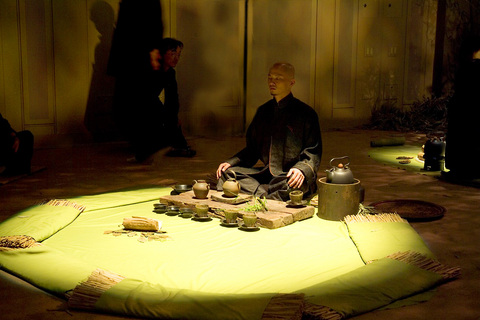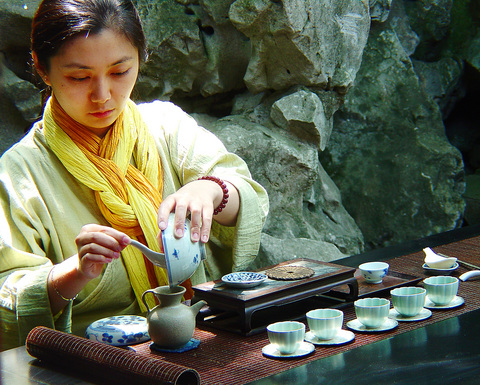When the British came to Taiwan in the 1860s, they made Formosa Oolong an international star and Taipei's Dadaocheng (大稻埕) and Tamsui (淡水) into prosperous tea-exporting centers. But the art of brewing and serving tea remained the possession of Chinese elites, who fostered a form of sophisticated tea brewing, often called kungfu tea (功夫茶), which originated in China's Fujian and Guangdong Provinces. Then the Japanese came, promoting the planting of black tea, and introducing Japanese and European tastes to local tea palate.
Fast-forward to Taiwan's economic boom in the 1980s. The popularity of tea drinking grew at a thundering pace as teahouses sprang up and new tea-preparation skills and etiquettes developed out of the kungfu tea tradition. From all of these factors, a distinct Taiwanese tea culture gradually emerged, and has since spread to Chinese communities across Asia. It even had an influence on China's tea culture revival in the 1990s.
The history of tea can easily be pick up from Ho Chien (何健), founder of Yeh Tang (冶堂), a tea space situated on a quiet alley off Yungkang Street (永康街). Having studied Taiwan's tea culture and history for the past 20 years, Ho has made his establishment into a Taiwan tea gallery showcasing a collection of folk antiques. While perhaps not museum-grade, they nevertheless preserve the collective memory and experience of tea drinking in Taiwan. It is a homey setting where visitors can calm the mind, have time with themselves and sip various local teas.

PHOTO: COURTESY OF CHRYSANTHEMUM CHAISM STUDIES
"To me, drinking tea is a way of life, an attitude toward life. It helps you to gain an insight into your relations with people, things and nature ... . There is no superior or inferior way with tea. If you are willing to explore its world, you can learn a lot. But if you are not, it's simply a good way to quench the thirst," said the tea connoisseur and historian.
Tea gets a still more philosophical interpretation at Teng (藤居), run by cultural luminary Chou Yu (周渝). It features rare antique tea dating as far back as the 1920s, organic tea and curios made by respected tea-makers such as Chen A-chiao (陳阿蹺), as well as antique furniture dating back to the Qing Dynasty. Chou sees tea drinking as an integral part of Daoism, Confucianism and Chinese Buddhism — a means of self-cultivation. He is a self-taught specialist in old pu'er teas, and since 2003 has worked with tea growers in China's Yunnan Province to make teas in accordance with revived ancient techniques.
As any tea connoisseur will know, tea, like red wine, is alive and constantly changing, allowing drinkers to relish a huge variety of flavors depending on preservation and preparation. "Hold the tea in the mouth, take a breath, let the imagination roam and you can see the landscape where the plant is grown," said Chou, demonstrating how to appreciate tea's natural elements.

PHOTO: COURTESY OF CHRYSANTHEMUM CHAISM STUDIES
Compared to new teas, Chou believes old tea has a more cultural dimension — the sense of time lends the drink significances as a cultural carrier, and the tea's history serves as the starting point from which people learn to reflect and cultivate the mind and soul.
"There is always some part of our past we don't want to face and our lives are very often twisted or oppressed by our personal histories. I believe that from old tea we can learn to keep an aesthetic distance from the past and be able to gain insights into the way of things," Chou said.
Speaking of the Classic of Tea (茶經) written by Lu Yu (陸羽) in the Tang Dynasty, Chou said the meticulous details of the tea-making and brewing reflect an Eastern way of thinking that fosters a sensitivity to the ever-changing environment and achieves a state simplicity by the understanding of its complexities.
"In Western culture, reason and sensibility stand opposite to each other, whereas in the East, there is no distinction between the two. Eastern culture speaks of a state of consciousness, of being sensitive to all things. And such is the spirit embodied in tea," Chou said.
According to Ho of Yeh Tang, Taiwan's tea art has developed multiple facets over the past 30 years, flourishing in diverse combinations with music, ceramic art, calligraphy and Chinese painting. The Chrysanthemum Chaism Studies (人澹如菊茶書院) founded by Li Shu-yun (李曙韻) is a celebrated example of the experimental spirit of Taiwan's creative tea culture.
First established in Chiayi City (嘉義市) over a decade ago, Chrysanthemum Chaism Studies has now moved to Taipei, and holds regular tea workshops combining traditional music such as guqin (Chinese lute, 古琴) and nanguan (南管), calligraphy, Chinese opera and floral art.
Running the risk of provoking conservatives, Li further explores the possibility of tea space by combining tea ceremonies with installation art and her workshops have even crossed over into theater, being performed at the theater space Taipei Eye (台北戲棚).
"Throughout history, tea has always played an auxiliary role to other artistic and spiritual practices. It can go with many other things as it is rooted in life. When tea culture and etiquette grow mature, it can become an independent art form," Li said.
While experimenting with tea as a creative form of expression, Li has also returned to basics by staging intimate, small workshops in a secluded tea house in Yangmingshan (陽明山).
"Unlike China, Korea and Japan, Taiwan hasn't developed an institutional system for tea study. It can be our flaw or our biggest strength, as each and every voice can be heard and contested in an energetic, free environment," said the reticent tea connoisseur who usually avoids media limelight.
At Li's Off Chaism (別茶院), a teahouse with a wide collection of teas mainly from Taiwan, China, Japan and India, visitors are left alone to listen to teas murmuring their own stories about the lands they are from.
As the globe has undergone enormous climatic changes, Li points out that there is no other time in history when we need to put so much effort into tea study and focus on skills to prepare a cup of good tea. The connection? The deterioration in tea quality resulting from changes to the Earth and it climate.
"You can really feel the Earth's rebellion ... I believe water will become a key factor in tea culture as it is more and more difficult to have a pot of good water," Li lamented. But in the meantime, Li does what she can to preserve a place to cultivate peace of mind and ancient wisdom.

On April 26, The Lancet published a letter from two doctors at Taichung-based China Medical University Hospital (CMUH) warning that “Taiwan’s Health Care System is on the Brink of Collapse.” The authors said that “Years of policy inaction and mismanagement of resources have led to the National Health Insurance system operating under unsustainable conditions.” The pushback was immediate. Errors in the paper were quickly identified and publicized, to discredit the authors (the hospital apologized). CNA reported that CMUH said the letter described Taiwan in 2021 as having 62 nurses per 10,000 people, when the correct number was 78 nurses per 10,000

May 5 to May 11 What started out as friction between Taiwanese students at Taichung First High School and a Japanese head cook escalated dramatically over the first two weeks of May 1927. It began on April 30 when the cook’s wife knew that lotus starch used in that night’s dinner had rat feces in it, but failed to inform staff until the meal was already prepared. The students believed that her silence was intentional, and filed a complaint. The school’s Japanese administrators sided with the cook’s family, dismissing the students as troublemakers and clamping down on their freedoms — with

As Donald Trump’s executive order in March led to the shuttering of Voice of America (VOA) — the global broadcaster whose roots date back to the fight against Nazi propaganda — he quickly attracted support from figures not used to aligning themselves with any US administration. Trump had ordered the US Agency for Global Media, the federal agency that funds VOA and other groups promoting independent journalism overseas, to be “eliminated to the maximum extent consistent with applicable law.” The decision suddenly halted programming in 49 languages to more than 425 million people. In Moscow, Margarita Simonyan, the hardline editor-in-chief of the

Six weeks before I embarked on a research mission in Kyoto, I was sitting alone at a bar counter in Melbourne. Next to me, a woman was bragging loudly to a friend: She, too, was heading to Kyoto, I quickly discerned. Except her trip was in four months. And she’d just pulled an all-nighter booking restaurant reservations. As I snooped on the conversation, I broke out in a sweat, panicking because I’d yet to secure a single table. Then I remembered: Eating well in Japan is absolutely not something to lose sleep over. It’s true that the best-known institutions book up faster